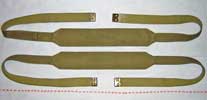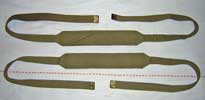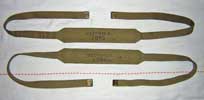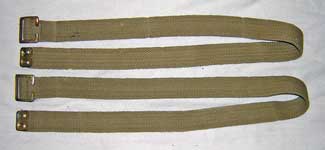Web Infantry Equipment, Pattern 1937
Braces and Straps
Stores Ref. A1/AA 0355 Brace, right, W.E. Patt. ‘37
The Brace, W.E. Patt. 37, left, with loop, and Brace, W.E. Patt. 37, right, without loop, were an old design, going back to Mills’ first use of “reduction weaving” to give a lighter Brace, but leaving a flared shoulder section, as used on Patt. ’13 W.E.. As was usual, they were handed, the left hand Brace having a cross-over loop at the rear, the nomenclatures in War Office documentation recording “…without loop…” as well. Following normal nomenclature practice, this was dropped, leaving only the left-hand Brace qualified with its difference.

 The Brace, W.E. Patt. 37, left, with loop, and Brace, W.E. Patt. 37, right, without loop, were introduced with Web Equipment, Pattern 1937, by List of Changes L. of C. §B1623, dated 8th June 1938. This khaki blancoed pair is maker marked "M.E. Co." and dated 1939. From the Karkee Web Collection.
The Brace, W.E. Patt. 37, left, with loop, and Brace, W.E. Patt. 37, right, without loop, were introduced with Web Equipment, Pattern 1937, by List of Changes L. of C. §B1623, dated 8th June 1938. This khaki blancoed pair is maker marked "M.E. Co." and dated 1939. From the Karkee Web Collection.
Variant Designs
As early as 1939, other manufacturers had to be brought in to meet demand. With few exceptions, these had no prior experience of manufacturing web accoutrements and none could not reproduce the “reduction weaving” process. Braces were therefore made in pieces, stitched together, the 1-inch strapping being mated to the 2-inch flare in several ways. These were not distinguished by different codes, or nomenclatures, so terms were coined for clarity by the writer:-
a) attached to – the commonest form, the cut ends of the 1-inch straps turned under and stitched to the flare, with its cut ends turned in at 45º and stitched, to form the tapered flare ends.
This Brace, maker marked "AC" (Associated Cutters) and dated 1943, is an example of the "attached to" variation. From the Karkee Web Collection.
b) wrap-around – woven extensions, on the sides of the flare, are turned in over the cut end of the 1-inch straps and stitched.
Another economy variant Brace, this one of the "wrap-around" type. Also note the Sheradised steel end pieces. This Brace is maker marked "M.W. & S. Ltd." and dated 1944.
This photo was supplied to KW by Joe White. It shows another "wrap-around" Brace, but this one maker is marked "M.E.Co." and dated 1943, which confirms that both of the major British webbing manufacturers made this style of Brace. From the Joseph White Collection, photo © Joseph White 2010.
c) straight-through – a two-piece construction, observed on Canadian manufactured items only. It comprised a tubular flare, through which a complete length of 1 inch strapping was passed. The ends of the flare folded in and stitched to a taper.
d) pinched –a variation of (c) above, but a three piece construction, where the cut ends were only inserted in the ends of the tubular taper and stitched into place.
e) tubular - a variation where the entire Brace is a flattened tube of thin, single weave webbing. In the center, the seam is left unwoven. The edges are then stretched apart at the center and sewn to make a lozenge shaped area tapering up to 2-inches wide. Sizing was added to keep the center section flat. Interestingly, this design is a reversion to the earliest form of Brace for Web Equipment, Pattern 1908, where 1st issue Patt. '08 Braces used this technique.
This example of tubular construction is maker marked "M.E. Co." and dated 1940. From the Chris Pollendine Collection, photos © Chris Pollendine 2012.
Another example, also M.E. Co. made and 1940 dated. This example came from a set of W.E. Patt. '37 all dated 1940, and issued to 31857 Munro, a signalman with the New Zealand 2nd Divisional Signals. From the Barry O'Sullivan Collection, photos © Barry O'Sullivan 2012.
Examples are known of M.E.Co. manufacture, but surprisingly made to style (a) above. From 1943, these can be found with Sheradised Tips, 1-inch, and post-war ones had Bonderised Tips. Another form of economy manufacture saw laminated, rubberised light canvas strapping being used. Examples are known of a further economy, where M.E.Co. fitted Tufnol Tips to Braces, in order to conserve brass. No official documentation exists, so this was more probably Mills’ own initiative to conserve a strategic material.
Stores Ref. A1/AA 0354 Brace, W.E. Patt. ’37, left, normal
Stores Ref. A1/AA 0355 Brace, W.E. Patt. ’37, right, normal.
When long Braces were introduced, the original nomenclatures were revised, as shown and examples manufactured in the original length from 1941 are marked “NORMAL”.
Stores Ref. A1/AA 5016 Brace, W.E. Patt. ’37, left, long,
Stores Ref. A1/AA 5017 Brace, W.E. Patt. ’37, right, long

 The best trials can only achieve just so much; real results only appear after a period of “in-service” use. A deficiency was identified, where taller men experienced difficulty with the existing Braces, which were too short to leave adequately long “ends” for the attachment of the Haversack and Water bottle carrier. This information does not derive from official documentation, since none was given. Instead, it comes from personal experience! Accordingly, in 1941, L. of C. §B4510 added longer versions of left and right Braces. Although the L. of C. entry is dated 1941, 1940 dated examples are known from both M.E. Co. and M.W. & S. Ltd. This pair is maker marked "M.E. Co." and dated 1940. From the Karkee Web Collection.
The best trials can only achieve just so much; real results only appear after a period of “in-service” use. A deficiency was identified, where taller men experienced difficulty with the existing Braces, which were too short to leave adequately long “ends” for the attachment of the Haversack and Water bottle carrier. This information does not derive from official documentation, since none was given. Instead, it comes from personal experience! Accordingly, in 1941, L. of C. §B4510 added longer versions of left and right Braces. Although the L. of C. entry is dated 1941, 1940 dated examples are known from both M.E. Co. and M.W. & S. Ltd. This pair is maker marked "M.E. Co." and dated 1940. From the Karkee Web Collection.
Stores Ref. A1/AA 5017 Brace, W.E. Patt. 37, long
Stores Ref. A1/AA 0355 Brace, W.E. Patt. 37, normal
Stores Ref. A1/AA 5016 Brace, W.E. Patt. ’37, left, long,
Stores Ref. A1/AA 0354 Brace, W.E. Patt. ’37, left, normal
In a move that was aimed at simplification in production, the left Braces (with loops), of both sizes, were made obsolescent. L. of C. §B8685, approved 15 Nov, 1943, removed the handed reference to the Braces, right to give the revised nomenclatures above. Future production of Braces would be without the loop. It can be speculated that, being in the run-up to D-Day, increased production of W.E. was helped by deleting this extra manufacturing operation. As an aside, the cross-over loop served little purpose anyway and, on taller soldiers, use of the loop caused a untidy look, as the sections below the restrained crossing did not align with the back buckles on the Belt. Some loops were made much longer.
Stores Ref. CN/AA 0355 Web Equipment, Patt. ‘37, Brace, normal
Stores Ref. CN 0356 Web Equipment, Patt. ’37, Brace, long
In 1951, L. of C. §C4686 transferred Section A1 of the V.A.O.S. to a new Section CN in the Catalogue of Clothing and Necessaries. It finally made the left hand Braces obsolete, leaving the two sizes of Brace above. Because the long Brace had been N.I.V., it only attracted a CN prefix, not the full “CN/AA”.
Stores Ref. A1/AA 0019 Attachment, brace, W.E. Patt. 37
Stores Ref. CN/AA 0019 Web Equipment, Patt. ’37, Attachment, brace
This was another old concept, dating from 1913, but first used with the Buckle, gate-leg, 2 1/4-in. on W.E., Patt. ’19. From the outset, the connecting link was rectangular, not round, as with early supplies of Patts. ’19 and ’25.

 Attachments, brace, W.E. Patt. 37 were introduced with Web Equipment, Pattern 1937, by List of Changes L. of C. §B1623, dated 8th June 1938. Brace attachments were used to attach the front of the Braces to the Waist belt without either Basic pouches or Cartridge carriers. This pair is maker marked "M.E. Co." and dated 1940. From the Karkee Web Collection.
Attachments, brace, W.E. Patt. 37 were introduced with Web Equipment, Pattern 1937, by List of Changes L. of C. §B1623, dated 8th June 1938. Brace attachments were used to attach the front of the Braces to the Waist belt without either Basic pouches or Cartridge carriers. This pair is maker marked "M.E. Co." and dated 1940. From the Karkee Web Collection.
Stores Ref. A1/AA 1711 Strap, shoulder, haversack, W.E. Patt. 37, left
Stores Ref. CN/AA 1711 Web Equipment, Patt. ’37, Strap, shoulder, haversack, left
Stores Ref. A1/AA 1712 Strap, shoulder, haversack, W.E. Patt. 37, right
Stores Ref. CN/AA Web Equipment, Patt. ’37, Strap, shoulder, haversack, right
Like the Patt. ’08 Haversack, the Patt. ’37 version could be transferred to the wearer’s back in Battle Order. It differed in being worn “rucksack” fashion, in the manner of the Patt. ’19 Rucksack. Where that had used attached straps, those of Patt. ’37 were separate items, which buckled (’08 style) to 2-inch angled tabs on the Haversack. List of Changes entry L. of C. §B1623 phrases things incorrectly, “…Straps, Shoulder are for carrying the haversack rucksack fashion on the patt. ’08 pack…”, which would have been a strange combination. Quite apart from the lack of capitals, it should have said “…haversack rucksack fashion or the patt. ’08 pack…”. Whilst M.E. Co. and M.W. & S. Ltd. used reduction weave for the 2-inch part of the Strap, other manufacturers used a four-piece construction, counting the brass hook. The 2-inch flare was mated as in the Braces - using style a and b above - to a short 1-inch web section joined to the hook. In a further economy measure, some were made without the Tips, brass, 2-in.

 The Strap, shoulder, haversack, W.E. Patt. 37, left, and Strap, shoulder, haversack, W.E. Patt. 37, right, were introduced with Web Equipment, Pattern 1937, by List of Changes L. of C. §B1623, dated 8th June 1938. Haversack straps are often referred to as "L-straps" by collectors. This pair is maker marked "M.E. Co." and dated 1939. From the Karkee Web Collection.
The Strap, shoulder, haversack, W.E. Patt. 37, left, and Strap, shoulder, haversack, W.E. Patt. 37, right, were introduced with Web Equipment, Pattern 1937, by List of Changes L. of C. §B1623, dated 8th June 1938. Haversack straps are often referred to as "L-straps" by collectors. This pair is maker marked "M.E. Co." and dated 1939. From the Karkee Web Collection.
Stores Ref. A1/AA 1990 Yoke, for Pouches, utility
Stores Ref. CN/AA 1990 Web Equipment, Patt. 37, Yoke
 The Yoke, for Pouches, utility, was a short strap, with a flare, that connected the Pouch, utility, front, to the Pouch, utility, rear, so that they could be slung over the shoulder. The Utility pouches and their Yoke are covered on the W.E. Patt. '37 Basic & Utility Pouches page, but the Yoke is also included here for completion. This example is maker marked "M.E. Co." and dated 1939. From the Karkee Web Collection.
The Yoke, for Pouches, utility, was a short strap, with a flare, that connected the Pouch, utility, front, to the Pouch, utility, rear, so that they could be slung over the shoulder. The Utility pouches and their Yoke are covered on the W.E. Patt. '37 Basic & Utility Pouches page, but the Yoke is also included here for completion. This example is maker marked "M.E. Co." and dated 1939. From the Karkee Web Collection.
 The inside view of the same Utility pouch yoke.
The inside view of the same Utility pouch yoke.
(No Stores ref ) Web Equipment, Pattern 1908, Strap, supporting
Stores Ref. A1/AA 1731 Strap, web, supporting, W.E. Patt. ’08
Stores Ref. A1/AA 1731 Strap, supporting, pack 1946
Stores Ref. CN/AA 1731 Web Equipment, Patt. ’37, Strap, web, supporting pack
 Nomenclature-wise, the Strap, supporting, had chequered history, those above being a simplified list, starting with the old Section 1A nomenclature under the Priced Vocabulary of Stores (P.V.O.S.). Up to 1920, this had been arranged alphabetically, but with Patterns ’14, ’08 W.E., ’03 B.E., ‘88 V.E. and ’82 V.E. grouped at the end. In 1924, the publication became the Vocabulary of Army Ordnance Stores, the old Section 1A being inverted to A1. The whole V.A.O.S. was placed in alphabetical order, giving a sub-group “Straps”, which ran through Straps, black; Straps, brown; Straps, buff; Straps, steadying and finally Straps, web. Under the last were Greatcoat, B.E., Patt. ’03 and Supporting, W.E., Patt. ’08. This introduced the grammatically redundant word “web” being coupled to “W.E.”.
Nomenclature-wise, the Strap, supporting, had chequered history, those above being a simplified list, starting with the old Section 1A nomenclature under the Priced Vocabulary of Stores (P.V.O.S.). Up to 1920, this had been arranged alphabetically, but with Patterns ’14, ’08 W.E., ’03 B.E., ‘88 V.E. and ’82 V.E. grouped at the end. In 1924, the publication became the Vocabulary of Army Ordnance Stores, the old Section 1A being inverted to A1. The whole V.A.O.S. was placed in alphabetical order, giving a sub-group “Straps”, which ran through Straps, black; Straps, brown; Straps, buff; Straps, steadying and finally Straps, web. Under the last were Greatcoat, B.E., Patt. ’03 and Supporting, W.E., Patt. ’08. This introduced the grammatically redundant word “web” being coupled to “W.E.”.
In 1946, when Patt. ’08 was made obsolete, its Pack and Straps were retained for use with Patt. ’37. The L. of C. incorrectly rendered the Extended use item as Strap, supporting, pack, adding pack (a word that had never appeared before), but omitting the word web, which was still needed as Straps, web, greatcoat were still only obsolescent, until made obsolete in 1947. The nomenclature was then correct, at last. Then in 1951, L. of C. C4686 suddenly – and un-necessarily - introduces web again, whilst incorrectly losing the comma between supporting and pack. It was this L. of C. that finally gave the Pack and its Straps a Patt. ’37 nomenclature.
The wartime production standard was that of the last version of the Great War issues, with eyeletted weather flaps and stitched-only 2-inch tabs. Wartime economies saw some with flap straps being made in laminated, rubberised canvas and with the Tips, brass, 2-in. deleted, as with the Haversack.
The pair shown here are maker marked "H&S Ltd." and dated 1939. Interestingly, the brass tips are stamped with the broad arrow and the letter "N", indicating Naval service. From the Karkee Web Collection.



